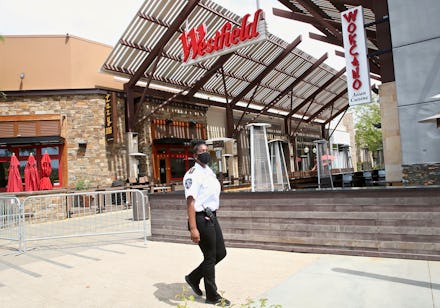Will coronavirus be the end of the shopping mall as we know it?

My mom told me she hit her quarantine breaking point the other day. She’s a registered nurse and follows the CDC’s social-distancing guidelines to the letter. But she also just got a new phone and needed a new case. The Best Buy website said she could pick one up in-store, and she doesn’t love online shopping, so she thought she’d pop over and browse in-person. She got all the way to the parking lot before she realized, of course, that Best Buy isn’t open right now. And she felt silly, but she also felt like crying, sitting there in her car in the empty parking lot. For a moment, she’d forgotten the world was topsy-turvy, and crashing back to pandemic reality sucked.
Coronavirus has changed the way we shop in countless ways. Mostly, people who didn’t shop online before COVID-19 are doing it in greater numbers because they have to. But notably, with so many out of work and the economy on shaky ground, people are limiting their spending to essential items. “Right now everybody’s focused on getting enough food, toilet paper and whatever you need to live,” Mike Shapaker, chief marketing officer at ChannelAdvisor, told Bloomberg.
The pandemic has slammed brick-and-mortar shops and ecommerce retailers alike — except for behemoths like Amazon, which reported a 26% spike in sales during the first part of 2020. But malls are getting especially pummelled. The traditional shopping mall was hobbling along well before the health crisis. The two big retail sectors that malls depend on, clothing and department stores, have underperformed over the last nine years. Back in 2017, Credit Suisse predicted that 25% of America’s malls, or 275, would be closed by 2022.
Along with every other gathering place known to man, malls in the US shuttered in March amid the growing health crisis. Some, in states like Georgia and Texas, have begun reopening in recent weeks with new safety precautions in place. Masks are required and stores limit the number of customers allowed inside at one time. The food court is roped off. Security guards hand out free hand sanitizer. Foot traffic is, predictably, far below what it was this time last year, but some people are clearly eager to get out of the house. Disappointingly, only a fraction of retailers inside are actually open. “If the foot traffic is not there, or the extra measures required are too much to bear from a payroll perspective, we could close our doors or not reopen,” an unnamed executive of a luxury clothing brand told The New York Post.
Lots of familiar brands may not reopen their stores at all. Before this whole mess, Forever 21, Barneys New York, Payless ShoeSource and Modell's Sporting Goods all filed for bankruptcy. The pandemic has now taken down J. Crew, Neiman Marcus and J.C. Penney, which is closing 240 of its stores as part of its bankruptcy protection plan.
“Before the crisis, you had a split between strong retailers like Amazon, Wal-Mart, Costco, Target, and weaker companies like Macy's, J. Crew, J.C. Penney, Neiman Marcus. And what's happening now is that the stronger players are getting even stronger, becoming even more dominant, and the weaker ones that have had to close stores during the crisis have really been devastated. So we're seeing a real split between winners and losers, and this crisis has really reshaped the industry," Nathaniel Meyersohn, CNN business retail reporter, recently told WBUR in Boston.
Amazon is reportedly in talks with J.C. Penney to buy the ailing department store chain, which brings us to what malls could look like when public life eventually returns to normal. Before the pandemic, some ailing malls had started repurposing their spaces to meet modern needs. Some have been converted into hospitals and churches. Others have been reimagined as living spaces. Amazon’s interest in a brick-and-mortar mainstay like J.C. Penney suggests a future dominated by the ecommerce giant and its competitors. Instead of Macy’s and Claire’s, every mall could be dominated by a Whole Foods and an Amazon Prime pickup center. It seems antithetical to the social gathering places that malls used to be. Browsing the wares IRL with your friends was half the fun. If smaller shops and department stores never bounce back and in-person shopping is dominated by Amazon and big box retailers forever, something special will be lost.